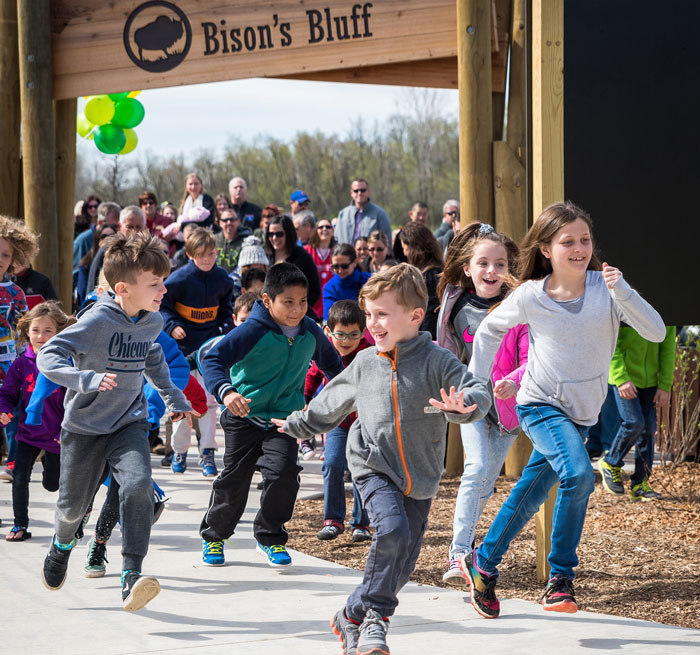Perusing the 2023 American Society of Landscape Architects (ASLA) Professional Awards, you can find many examples of innovative parks. In Westfield, Ind., just after work began on a new 7.8-acre park design, a 500-year storm event meant the Grand Junction Park & Plaza needed to transform into a forward-thinking infrastructure project needed for the mitigation of flooding, as well as a vibrant town center featuring many amenities and events. In Charlestown, Mass., a new sloped bike pavilion raises the site out of the anticipated coastal flood zone and caps contaminated soils while providing an outdoor event space, transforming the former industrial site into the Hood Bike Park.
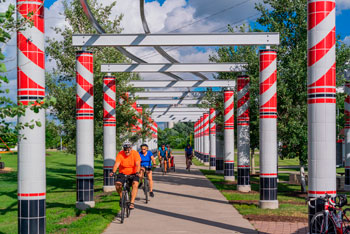
While concerns like climate resiliency and stormwater management are urgent, so is the need to provide outdoor spaces for leisure, recreation and entertainment, and make sure these spaces are inviting and accessible to everyone. And just as public desires evolve, so do the requirements of these spaces, and designers must innovate, balance and roll with the punches.
“Park design is evolving with innovative trends to enhance user experiences,” said Lacey Lawrence, principal at Hitchcock Design. She explained that outdoor smart parks are emerging, offering Wi-Fi, power access and shaded areas for connectivity and comfort. “Tech-infused play adds a modern twist to recreational activities.”
Ninja warrior and challenge courses cater to adventurous spirits, she said, while air-supported domes enable year-round play and multi-use sport courts adapt to seasonal demands, transforming from ice rinks to pickleball courts. “Additionally, the incorporation of passive garden spaces, themed learning areas and art gardens—especially at library sites and arboretums—adds a touch of tranquility and educational opportunities to enrich park experiences.”
One idea continuing to gather steam is destination parks, according to Doug Bisson, urban design and planning principal at HDR. Designing “to have multiple attractions for the park to be programmed continually; that way you ensure the investment is utilized.”
He mentioned the Omaha RiverFront Revitalization project, containing features designed to accommodate programmed activity. Major events may happen monthly, while other activities take place daily, weekly and biweekly. “…if you go down to the park, there’s going to be multiple activities happening. That seems to be really catching on across the country, and it’s hugely valuable because it creates really great spaces. People want to be around other people.” He added that spinoff benefits include the increasing of adjacent property values, as others want to build next to these sites.
Mike Bell, partner at RDG Planning & Design, reminded us that while the Industrial Revolution brought numerous benefits to society, it also created significant challenges for many urban centers and industrial communities, including overcrowding, pollution and despair. But green spaces helped provide a remedy for these challenges. And recently, COVID helped remind us to better appreciate the importance of green and blue systems to our physical and mental health, according to Bell. Therefore, comprehensive community planning and park design will prioritize these systems as basic infrastructure.
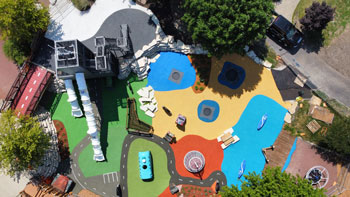
Bell added that these networks will need to permeate through the entire community, incorporating streets, housing, industry and commercial districts. “To be truly innovative in community planning, the impact of green and blue systems on health and wellness will be a foundational criterion for future success. There must be more than parks, open spaces and trails; living within a network of green and blue will help ensure a healthier society.”
There have been heightened efforts to make parks, playgrounds, aquatics facilities and sports venues welcoming to all. “Recent innovations in parks are fully inclusive parks,” said Hana Ishikawa, design principal at Site Design Group. “There has been a lot more research done on what inclusivity is defined as, as well as really starting to study the innovative ways every person—or animal—can be included in our park designs. Truly inclusive parks, we believe, bridge those with different ages, physical developments, cognitive developments, social developments and backgrounds together so that it can be for everybody.”
Mary Chow, civic principal at HDR, agreed, and said there’s been a revival of the concept of equitable spaces in indoor and outdoor recreational venues. “With the consistent decline in participation in sport and recreation for girls and women, and a strong desire to create inclusive and equitable spaces for all individuals, recreation professionals are renewing their focus on removing barriers from parks to increase participation and usage from underserved groups.”
Chow mentioned data showing that females used park spaces less than their male counterparts. She listed some possible reasons, including feeling vulnerable in large, open spaces; an inherent desire to look for safe spaces; and a preference for “social seating” as opposed to typical park seating where visitors look out and away from one another. “Small interventions and considerations for varied perspectives are prompting designers to better consider how to create parks that will be well used by all demographics.”
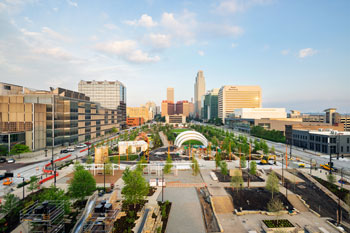
As environmental initiatives become increasingly important considerations, can these be balanced with providing public green spaces and fulfilling programming desires? “We’ve designed a few projects that go above and beyond the stormwater and natural resource conservation requirements as a desire for cities to use their park spaces as a natural sponge, to clean and store our declining resources throughout the country,” said Ishikawa, who explained that climate resiliency and a fully active park can exist together, it’s simply a balancing act, and “a decision on whether they should be daylit and above the ground and visible, or need to be below ground to create more space at grade for active programs.”
Lawrence said that addressing environmental concerns while meeting public desires involves innovative strategies, including reducing the heat island effect through thoughtful material selection, fostering urban tree canopies, and incorporating native plantings for runoff filtration, erosion protection and enhanced biodiversity of natural areas. “Embracing native area restoration, walking trails, boardwalks, scenic overlooks and innovative stormwater management not only enhances the project’s sustainability but also fosters resilience.”
Managing runoff onsite becomes critical, according to Lawrence, providing opportunities for rain gardens with interpretive environmental education for programming in areas like STEAM. “The process should include comprehensive site inventory and analysis, integrating storytelling elements and fostering community engagement.” By balancing these concerns, she said that municipalities can create spaces that withstand environmental challenges and cater to the recreational and educational needs of the public.
As populations grow, our built footprint expands and climate-related events increase, we must create a more flexible and resilient development pattern, according to Bell, and natural spaces provide some flexibility. “Park systems, if planned well, provide an important opportunity to enhance community resilience and improve quality of life, access to recreation and public health.”
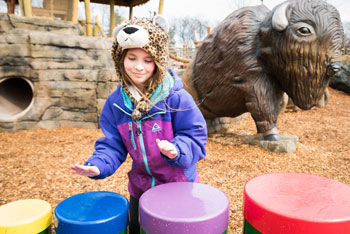
He mentioned Norman, Okla.—where the community is undertaking a city-wide master plan focused on community resiliency—as exemplifying an innovative approach to comprehensive planning. “AIM Norman covers a wide spectrum of city planning, including land use, transportation, stormwater management, water infrastructure, wastewater, parks and affordable housing. To ensure that Norman’s infrastructure aligns seamlessly with the comprehensive plan’s goals, we’re updating related plans.”
“Even though the full effects of climate change are unknown, most cities have experienced flooding and related water quality issues,” continued Bell. “Parks can become demonstration sites and showcases for improved stormwater management and habitat restoration to help mitigate the impacts of climate change and show others how climate change mitigation can and should be done.”
More communities are working to reclaim underutilized or neglected “brown” spaces, but many of these areas were former industrial sites and harbor serious environmental concerns. Bisson said there’s always a fresh way to look at opportunities for spaces and different ways of addressing challenges by looking at and incorporating new science. “We’re able to activate large areas that currently aren’t overly active. Things can be done; can we create wetlands? Can we do check-ins to build pending areas so that contaminants can be burnt off over time? A lot is a phased approach that occurs over time, and activities that people want can be reintroduced.”
“It certainly feels like most of the sites we work on are considered brownfield sites,” said Ishikawa. She mentioned their Stearns Quarry/Palmisano Park project in Chicago, a former limestone aggregate quarry, “turned into a local dumping site for construction debris, and presently turned into an environmental educational park with outcropping terraces, a river and native species of various native habitats. It’s fairly easy to cap these brownfield sites with clean soils or membranes, but we feel it’s also important to keep the historical significance of the site and to use it as an educational opportunity so that we can inspire future generations to maintain the cultural identity of a site and to see its value through time.”
As many cities get increasingly crowded and green space is at a premium, innovations and strategies can help bring multiple uses to park sites. Lawrence said these include creating flexible gathering spaces with diverse seating and overhead covering. “These areas can serve as versatile venues for special events, team gatherings, programming, facility rentals and even opportunities for remote outdoor work.”
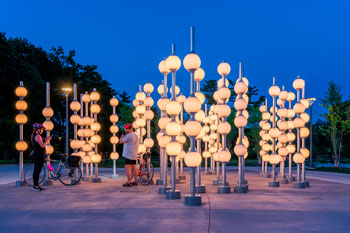
Practical considerations she mentioned include wide pathways for pop-up tents, portable restrooms, access to power/Wi-Fi, concessions, fencing for controlled circulation and lighting for evening activities.
Lawrence said material selection plays a crucial role in park site adaptability. Open spaces can be optimized for sports fields and special event programming with irrigation and water collection systems for high-use lawns, or even synthetic turf. “Underground detention under playgrounds and fields further maximizes the use of open space, presenting a dynamic solution to accommodate diverse community needs.”
As far as spaces being utilized for multiple uses, Ishikawa said they also consider seasonality, group sizes (independent users vs. group users), types of events, etc. “For example, a project we’re working on in Glen Ellyn (Illinois) will be a concert space with a full pavilion and stage in the warmer months and turns into an ice-skating rink in the winter. When neither program is happening, the space will be a larger lawn space with multiple forms of seating surrounding it.”
Areas in cities that are not within a 10-mile walk to a park, trail or recreation facility are considered underserved, according to Bell, and these areas are typically mapped during comprehensive parks and recreation planning efforts when analyzing levels of service. He offered some strategies that could increase residents’ access to local parks programming, including increasing the number of small parks—less than 10 acres—throughout the city. “Identify parcels of land in underserved areas that could be acquired for new park development.”
Another option is to build on existing infrastructure. “With current facilities, identify recreation opportunities that currently don’t exist and propose development as a permanent installation or provide facilities for infrequent use.” And finally, parks departments should initiate and expand pop-up programming activities, “promote the program, focus on underserved areas and offer comprehensive training to staff and volunteers to implement this program.”
Particularly in urban areas where space is limited and kids need places to play, it’s a goal to blend play elements into the aesthetics of the greater park site, and Lawrence said that integrating these features seamlessly together requires a thoughtful approach that embraces the existing site context and natural features, allowing designers to create a “harmonious blend of aesthetics and play opportunities. This involves incorporating creative custom play elements, merging nature-inspired features like mushrooms and log steppers with traditional play equipment.”
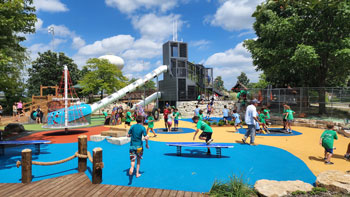
Lawrence said the design should encourage learning through play, fostering an understanding of the local context, and promoting inclusivity to ensure that everyone can enjoy the space. “The marriage of play features with the natural beauty of green spaces enhances both the visual appeal and functionality of the area, creating a dynamic and engaging environment for users of all ages.”
“We believe that beautiful, challenging and unique play environments are beacons and cultural identifiers of a neighborhood and are also places where communities can gather and communicate with one another,” said Ishikawa. For actual play features, she said they’ve been incorporating more features that blend art and play, or seating and play, or pathways and play, so that everyone—including adults—can “have a moment of reprieve and enjoyment that is not typical of their everyday life.
“We also have been working more on natural playgrounds which go through the natural decay and processes of change, as well as elements that can be moved or changed over time,” continued Ishikawa. “It’s sad to think that there were a few decades of park users where climbing trees or gathering materials on the ground is absolutely frowned upon, and we’re trying to reverse this trend that our landscapes are not only for visual beauty, but also places to inhabit.”
At the Jester Park Nature Center in Granger, Iowa, the outdoor playscape was “innovative in that it was developed around unscripted play and multigenerational involvement versus the tubular steel play structure standards,” said Bell. “It provides a safe and accessible venue for imaginative play that encourages children and families to move outdoors and away from their… technological diversions of modern life.”
The nature-inspired playscape was constructed using “naturally occurring, salvaged, recycled or donated materials.” Bell said they began the planning process by working with a team of Polk County conservation naturalists to identify resources that could be used from the surrounding park. “These materials included stone, timber, twigs, pebbles and native plantings. Polk County also has many talented artisans who lent their talents and fabricated some of the art found within the playscape.
“Other innovative aspects of the playscape are the stormwater quality measures implemented to reduce the playscape’s impact on its surrounding environment,” continued Bell, who said the site utilizes rain gardens, bioswales, pervious paving and indigenous plant materials within its boundaries to cleanse, cool and infiltrate stormwater that falls on the project site. “By incorporating these best management practices, the playscape reduces its development impacts on the larger park.”
Sports complexes are also experiencing innovative design transformations. Some projects in the works include a baseball complex in Iowa City with baseball, soccer and flag football fields, with themed gateways, batting cages, warmup areas, sports lighting, spectator seating, concessions and restrooms. But these facilities also cater to neighborhood needs, and other proposed amenities include shelters, a plaza, a destination playground with shaded seating, a dog run and accessible multipurpose trails with fitness stations, interpretive features and site furnishings. Sustainable considerations include water-quality features and native landscaping.
“A well-designed sports complex should prioritize creating a diverse and inclusive environment for multigenerational play,” said Lawrence, whose firm is working on the Iowa project. “This involves considering the needs of athletes and their families, including parents, siblings, grandparents and even pets.” Comfort features should include shade, drinking fountains, various seating options, restrooms, parking and accessibility, which are crucial for a positive user experience, according to Lawrence. “Designers should be intentional and creative in selecting the amenities that cater to the increasing demand for outdoor recreation in urban communities, especially when faced with limited resources.”
Lawrence explained that the design of sports complexes must extend beyond the recreational aspects and consider operational efficiency, emergency access and maintenance requirements. A comprehensive approach that factors in these elements ensures not only a seamless user experience but also the overall success and longevity of the facility. “Ultimately, the success of any public outdoor space lies in its ability to accommodate the diverse needs of users, encouraging a positive experience and fostering a desire to return.” RM



